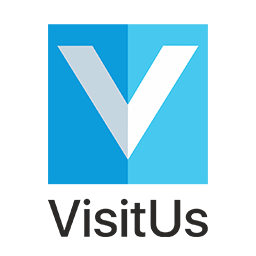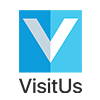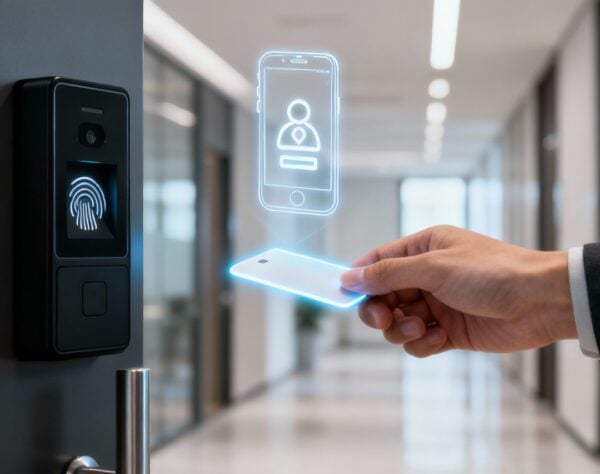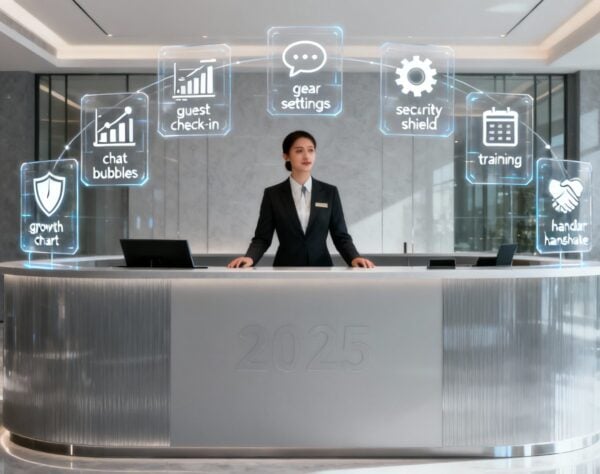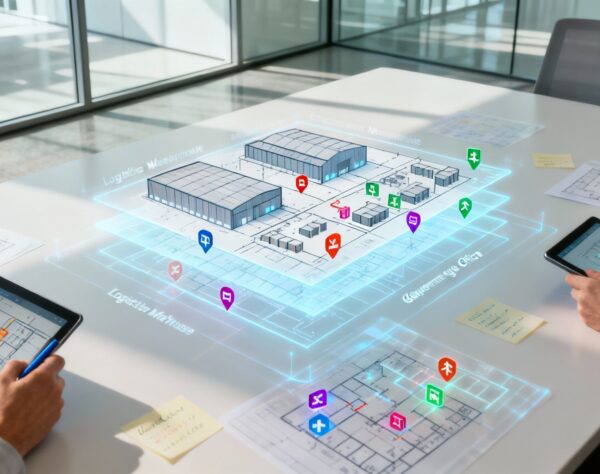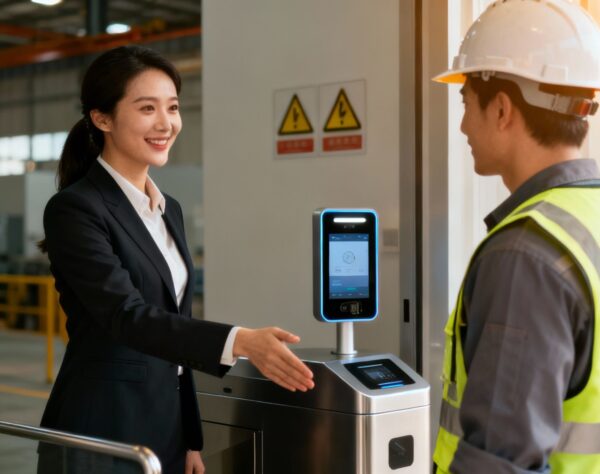
Improve Security with a Top Visitor Management System
Let's be honest, a paper sign-in sheet on a modern reception desk just feels wrong. It’s an outdated approach that creates needless risks and, frankly, leaves a poor first impression. That entire clumsy process is why a proper visitor management system has gone from a "nice-to-have" to a fundamental business tool, with the market projected to grow at over 16% annually.
Why Paper Logbooks Just Don't Cut It Anymore
We've all seen them—the dog-eared paper logbooks with their familiar columns. But their simplicity is deceptive. In reality, they're riddled with security gaps and create operational headaches. Messy handwriting, half-filled entries, and zero data privacy are just the tip of the iceberg. A smooth, digital check-in tells your visitors you’re competent and serious about security. A paper logbook, on the other hand, can suggest your other operational standards might be just as outdated.
The Hidden Costs of an Old-School Process
Beyond just looking bad, paper-based systems create real, tangible risks. One of the biggest flaws is simply not knowing who is in your building at any given moment. In an emergency, trying to account for everyone becomes a frantic guessing game based on an inaccurate sheet of paper. This inefficiency bleeds into daily operations, too, causing bottlenecks at the front desk and piling administrative work onto your staff. If you're ready to make the switch, you can learn more about how to move away from sign-in books with a visitor sign-in app.
The core problem with paper logs is the complete absence of control and visibility. Once a name is written down, the data is static, unsearchable, and insecure—exposing both your visitors' privacy and your organization's security to unnecessary risk.
A Growing Market Reflects a Fundamental Need
This shift toward digital isn't just a fleeting trend; it’s a direct response to a global need for better workplace security and efficiency. The global Visitor Management System (VMS) market was recently valued between USD 1.54 billion and USD 2.75 billion, demonstrating how widespread this technology has become.
And it’s not slowing down. The market is projected to grow significantly, with experts estimating compound annual growth rates between 12.45% and 16% over the next decade. This growth is fueled by massive demand for secure, efficient visitor tracking in critical sectors like healthcare, government, and IT. This financial momentum underscores a clear reality: a modern visitor management system is no longer a luxury but a necessary investment for any forward-thinking organization.
Strengthening Your Security and Compliance

A modern visitor management system is your first line of defense, transforming your reception desk from a simple welcoming spot into a real security checkpoint. This goes way beyond a sign-in sheet, creating a controlled environment where every entry is tracked and accounted for. That control starts long before a guest even steps through your door. One of the biggest security benefits is the ability to pre-register visitors. This simple step lets you know exactly who to expect and when, which immediately cuts down on the chaos of unscheduled arrivals. For facilities with tighter security, it’s an opportunity to handle background checks or get NDAs signed well in advance.
Picture the difference. An unexpected person shows up and demands to see an employee. Now compare that to a pre-screened guest who gets a unique QR code for a quick, touchless entry. The first situation is disruptive and risky; the second sets a secure, professional tone from the moment they arrive.
Achieving Total Visibility of Your Premises
Once a visitor is on-site, a digital system gives you a level of awareness that a paper log could never match. You get a clear, real-time picture of everyone inside your building, which is priceless for both daily operations and emergencies. This isn't just about knowing names; it's about having actionable information.
This complete visibility is built on a few key benefits working together:
- Instant Host Notifications: The second a guest checks in, their host gets an automatic ping via SMS, email, or even Microsoft Teams. This eliminates lobby bottlenecks and ensures visitors are never left waiting unattended—a potential security blind spot.
- Real-Time Visitor Logs: Security teams can pull up a live dashboard showing who is on-site, where they're supposed to be, and how long they've been there. This makes it easy to spot someone who has overstayed their welcome or wandered into a restricted area.
- Watch-List Screening: A powerful benefit is screening visitors against internal or external watch lists. The system can discreetly flag anyone who might be a security concern, letting your staff respond before a problem has a chance to start.
The real security advantage of a visitor management system is the shift from being reactive to proactive. Instead of digging through a logbook after an incident, you have the tools to stop security breaches before they even happen.
Mastering Compliance with Automated Audits
Meeting regulatory requirements isn't optional, and getting it wrong can be incredibly expensive. With the average cost of a data breach hitting $4.45 million in 2023, solid data handling is a must-have part of managing risk. A visitor management system delivers the framework you need for effortless compliance. Automated data logging creates a secure, digital, and auditable trail of every person who enters your building. This is critical for companies that must follow strict regulations like GDPR, ITAR, or HIPAA. For example, any business handling sensitive data needs to prove exactly who accessed their facility and when.
These digital records are instantly searchable and can be exported for audits in a snap, saving countless hours of admin work. You can learn more by checking out our guide to maintaining compliance with workplace entry logs in 2025. By automating these tasks, a visitor management system gives you peace of mind, knowing your records are accurate, secure, and always ready for inspection. It turns compliance from a headache into a smooth, integrated part of your daily routine.
Boosting Efficiency At Your Front Desk
A modern visitor management system does more than just tighten security—it transforms your front desk from a chaotic bottleneck into a model of efficiency. By automating the repetitive tasks that eat up a receptionist's day, you create a smooth, welcoming experience for everyone. Manual sign-ins, hunting down hosts, and printing badges can easily stretch a simple check-in into a five-minute ordeal. A digital system handles all of that in seconds, cutting down on visitor wait times and freeing up your admin staff to focus on more valuable work.
From Manual Overload To Automated Workflow
The workload on front desk staff is often heavier than it looks. They're juggling incoming calls, sorting mail, and handling employee requests, all while being the first point of contact for every single visitor. A digital system lifts a huge chunk of that weight, leading to real-world improvements in both productivity and morale. Instead of flipping through a paper logbook and making endless calls to track down a visitor's host, the system takes care of it. This automation hands back precious time to your receptionists, which translates directly into saved labor costs and a much more organized front office.
This side-by-side comparison shows just how different the two approaches are.
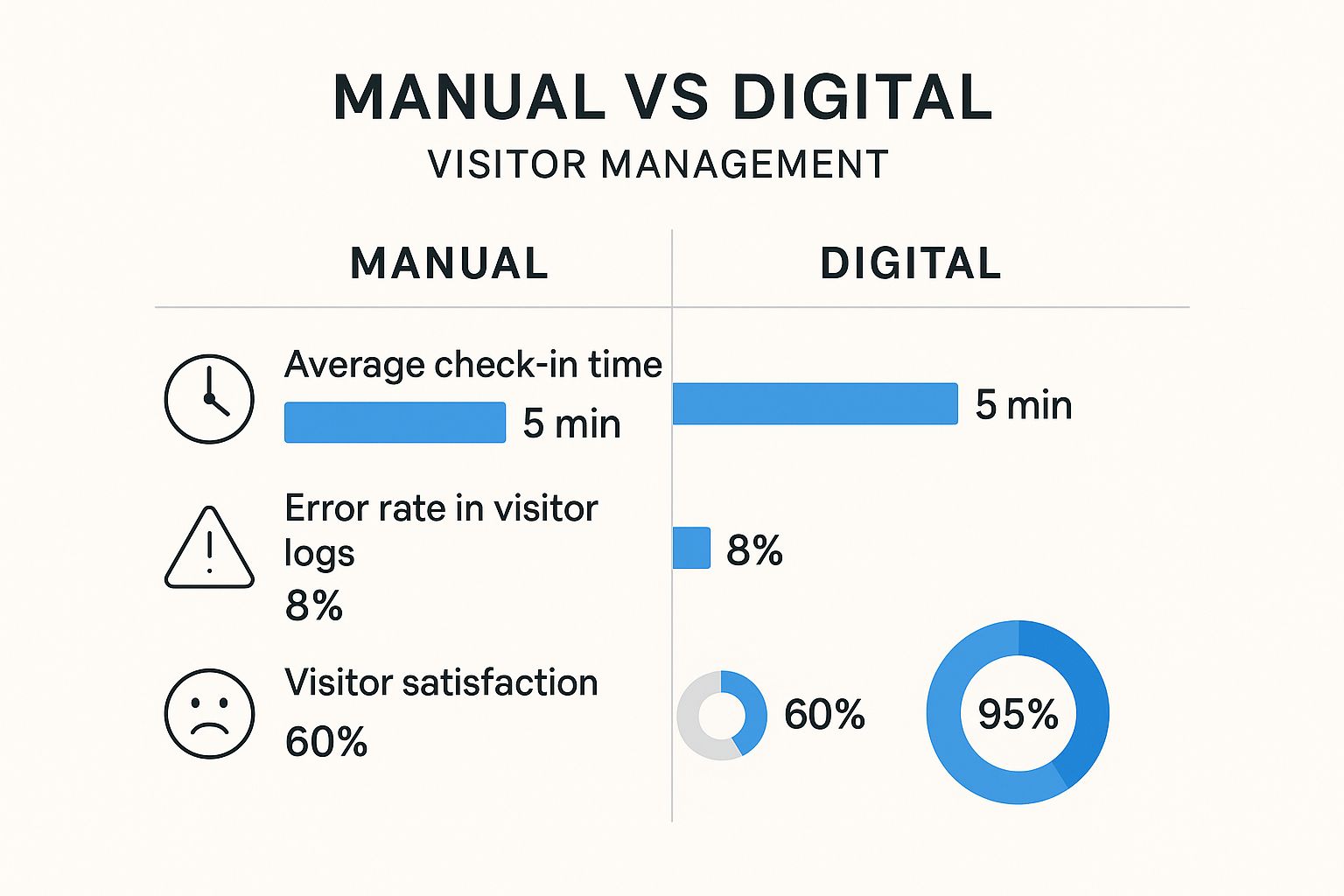
As you can see, a digital system doesn't just cut check-in time by a whopping 80%; it also slashes errors and makes visitors much happier.
Let's break down the old way versus the new way with a quick table.
Traditional Logbook vs Modern Visitor Management System
| Aspect | Traditional Paper Logbook | Modern Visitor Management System |
|---|---|---|
| Check-In Speed | Slow and manual; creates lobby queues. | Instant and automated; often self-service. |
| Data Accuracy | Prone to illegible handwriting and errors. | Clean, consistent, and accurate data capture. |
| Host Notification | Manual phone calls or messages. | Automatic email/SMS notifications. |
| Security | Minimal; visible to anyone at the desk. | Secure; data is encrypted and private. |
| Reporting | Difficult and time-consuming to analyze. | Instant, detailed reports on visitor traffic. |
| Professionalism | Can look outdated and disorganized. | Sleek, modern, and professional first impression. |
The difference is night and day. Moving to a modern system isn't just an upgrade; it’s a complete operational overhaul for your front desk.
The Rise Of Cloud-Based Solutions
This push for efficiency is largely powered by flexible, cloud-based technology. In fact, cloud deployments now account for over 60% of the market revenue share and are growing at a rate of around 16.6% each year. Why the surge? Businesses love that they eliminate IT maintenance and make it simple to manage multiple locations.
Going with a cloud-first approach gives you some serious advantages:
- Zero Maintenance: Your provider handles all the software updates and server upkeep, so your IT team can breathe easy.
- Ultimate Scalability: As you open new offices, a cloud system grows with you. No sweat. You get a consistent check-in experience everywhere.
- Centralized Control: You can manage visitor protocols, check analytics, and tweak settings for all your sites from one simple dashboard.
Much like a visitor management system streamlines your reception, finding the right tools for other areas, like small business inventory management, is key to boosting your company's overall efficiency.
The real benefit of a cloud-based system is its agility. It adapts to your business needs without requiring heavy upfront investment in hardware or ongoing IT intervention, making modern efficiency accessible to companies of any size.
Enhancing Your Professional Image
Efficiency isn't just about saving minutes—it's also about perception. A quick, professional check-in process leaves a fantastic first impression on clients, partners, and potential new hires. It immediately tells them your company is organized, modern, and respects their time. This polished experience reinforces your brand right from the moment they step inside. By removing lobby friction and creating a genuinely welcoming atmosphere, you set a positive tone for every meeting that follows. For a deeper dive, check out our guide on how to improve efficiency with a visitor sign-in system.
The Global Move to Smarter Workplaces

Implementing a modern visitor management system is about tapping into a global movement toward smarter, more connected, and safer business environments. Companies everywhere are realizing that a secure and efficient front entrance is a core part of modern operations. This wave is getting a major boost from large-scale projects like smart cities, which are weaving digital tools into the very fabric of urban life. As our cities get smarter, the buildings inside them have to keep up. A visitor management system is a crucial piece of that puzzle, bringing your office in line with the broader vision of a secure, digital-first community.
A Worldwide Business Standard
For any company with a global footprint, the advantages are massive. Imagine trying to enforce the same security and compliance rules across offices in New York, London, and Singapore. Relying on a jumble of paper logbooks and different local habits is an operational mess, opening up huge security gaps and compliance risks. A centralized, cloud-based visitor management system eliminates those problems. It lets a company roll out a single, standard way of handling visitor check-ins, security checks, and data privacy across all its locations. This means every office, no matter where it is, operates under the same high standard of security.
The real win for a global business is standardization at scale. A unified visitor management platform transforms a tangled web of international offices into a single, manageable ecosystem with consistent security protocols and a clear, auditable trail of every visitor interaction.
Fueling Growth in Emerging Markets
The push for smarter tech is especially strong in high-growth regions that are quickly modernizing their entire business infrastructure. These markets are often skipping over older technologies entirely and jumping straight to the most current solutions. You can see this playing out in the market numbers. The Asia-Pacific region, for example, is becoming a major growth engine for visitor management tech. Projections show its market is set to grow at a compound annual growth rate somewhere between 12.6% and 17.3% through the early 2030s. That incredible growth is directly linked to smart city initiatives and sweeping digitalization efforts in countries like China, India, and across Southeast Asia.
Aligning With Global Best Practices
At the end of the day, putting a modern visitor management system in place is a strategic move that puts your company in league with global leaders. It sends a clear signal to clients, partners, and your own team that your organization is serious about best practices in security, efficiency, and facility management. It shows you’re thinking ahead and investing in the tools needed to operate safely and effectively on a global stage. As workplace technology keeps evolving, having a sophisticated system is no longer just an operational choice—it’s a direct reflection of your company's commitment to excellence. To get a better feel for what's coming next, you can check out the future of visitor management trends to watch in 2025.
How to Choose the Right System for Your Business
Picking the right visitor management system isn't about finding the one with the longest feature list. It's about finding the solution that fits your business goals, fixes your unique headaches, and boosts your security, efficiency, and brand image. The trick is to look past the flashy tech and focus on the benefits that will genuinely make a difference for your team and your guests. So, where do you start? You start by asking a few simple but powerful questions about your own operations. The answers will be your compass, pointing you toward a system that feels like a natural extension of your business.
Define Your Core Needs and Priorities
Before you watch a demo, take a step back and define what "success" means for your company. A manufacturing plant has completely different priorities than a corporate high-rise or a healthcare clinic. Getting crystal clear on your main objectives is the single most important step you can take.
Start by asking these fundamental questions:
- What's our biggest security worry? Is it preventing unauthorized entry? Protecting sensitive information? Or just having an accurate headcount for fire drills? A company that handles confidential data will prioritize benefits like watchlist screening and built-in NDA signing.
- How many visitors do we get each day? A business with a handful of daily visitors has very different needs than one juggling hundreds. When you have high traffic, the benefits of pre-registration and self-service check-in kiosks skyrocket.
- Which software integrations would save us the most time? Think about the tools your team already lives in. A system that hooks into your access control, employee directory (like Microsoft's Active Directory), or chat platforms like Slack and Teams creates a seamless workflow and eliminates manual data entry.
The whole point of this exercise is to create a clear "problem statement." For instance: "We need a system that cuts down lobby congestion for our 50+ daily visitors and makes sure every contractor signs a safety waiver before they step onsite." This kind of clarity makes spotting the right solution a whole lot easier.
Look for Benefits, Not Just Features
Once you have a solid handle on your needs, you can start looking at potential systems. The key is to always connect a feature back to a real, tangible benefit for your business. A laundry list of features is completely useless if it doesn't solve a real-world problem for you. An easy way to do this is to just reframe how you think about it. Instead of asking, "Does it have badge printing?" ask, "Will this help my security team instantly tell who's an authorized guest from twenty feet away?" This benefit-first approach ensures you're investing in real value, not just bells and whistles.
The Guest Experience Matters More Than You Think
Let’s be honest, the check-in process is one of the very first real interactions a person has with your company. A clunky, confusing, or slow sign-in leaves a lasting negative impression on clients, partners, and even potential new hires. But a smooth, professional process communicates competence and respect for their time. A great guest experience is a huge benefit that directly reflects on your brand. Studies show that companies delivering a better customer experience can outperform their competitors by nearly 80%. The principle holds true for visitors—that positive first interaction sets the tone for everything else.
This is why an intuitive guest interface is absolutely non-negotiable. It should be so simple that a first-time visitor can breeze through it without any help. The benefit here isn't just a happy guest; it's a lighter workload for your front desk staff, who can focus on their job instead of playing tech support.
Plan for Your Future Growth
The system you choose today needs to be able to support your business tomorrow. Scalability is a critical benefit that keeps you from having to go through this whole stressful procurement process again in a couple of years. As your company grows, your needs will definitely change.
Ask yourself these forward-thinking questions:
- Can the system easily expand to new locations? If you plan on opening more offices, you'll want a platform that lets you manage every site from one central dashboard. This ensures your security protocols are consistent everywhere.
- Is the pricing model flexible? Look for a provider that lets you adjust your plan based on visitor numbers or how many locations you have. This way, you only pay for what you're actually using.
- Does the provider keep the software updated? A good partner will regularly push out new features and security patches, making sure your system evolves with new technology and new threats.
Choosing a scalable solution means you're not just putting out today's fires—you're making a strategic investment in your future. It gives you the peace of mind that your visitor management system will grow right alongside your business.
Answering Your Top Questions About Visitor Management
Even after seeing all the benefits, it's normal to have a few practical questions before bringing in a new system. You're probably wondering about the setup process, data security, and what the real return on investment looks like. Let's tackle those head-on so you can feel confident you're making the right choice. The goal here is to clear up any lingering doubts and show you just how simple the move to a modern, secure front desk can be.
How Long Does It Take To Get Started?
One of the biggest myths is that implementation is a long, drawn-out headache. The reality, especially with today's cloud-based systems, is completely different. For a single office, you can be up and running in just a few hours. Seriously, not weeks. The whole setup process is designed to be intuitive. It walks you through customizing your check-in flow, popping in your logo, and adding your employee list. The beauty of a modern visitor management system is that it doesn't demand a ton of IT resources, letting you get to a safer, more efficient lobby way faster than you'd think.
How Secure Is Our Visitor Data?
This is a big one, and it should be. Data security is non-negotiable. Shifting away from a paper logbook isn't just about efficiency; it's a massive security upgrade. Any reputable visitor management platform is built with layers of protection to keep your company's—and your visitors'—information locked down.
Here’s a quick look at the benefits of this secure approach:
- Data Encryption: All information is encrypted, both when it's being sent and when it's stored. This scrambles the data, making it unreadable to anyone who shouldn't see it.
- Secure Cloud Hosting: Your data lives in highly secure data centers that meet tough international security standards like ISO 27001.
- Access Controls: You're in the driver's seat. You decide who in your organization can view visitor data, ensuring sensitive info stays private.
In an age where data breach costs are staggering, a system that actively protects visitor information isn't a "nice-to-have"—it's a critical part of managing risk.
Can It Integrate With Our Existing Software?
Absolutely. This is where you see the benefit of enhanced efficiency. A good visitor management system isn't an island; it's designed to connect with the tools your team already uses every single day. These integrations eliminate mind-numbing manual data entry, which some research shows can cost companies up to 30% of their revenue due to simple mistakes and wasted time.
A few of the most valuable connections include:
- Employee Directories: Syncing with something like Microsoft's Active Directory means your employee list is always current, with no manual updates needed.
- Communication Tools: Hooking into Slack or Microsoft Teams lets you send instant host notifications right where your team is already working.
- Access Control Systems: By linking your visitor system to your door locks, visitor badges can be programmed to grant access only to specific areas for a set amount of time. It's a huge boost for physical security.
These integrations create a smooth, automated workflow that saves time and cuts down on the chance of human error.
How Do We Calculate the Return on Investment?
Figuring out the ROI for a visitor management system goes way beyond the monthly subscription fee. The real value is a mix of hard cost savings and major boosts in efficiency and security. I like to break it down into "hard" and "soft" returns.
Hard ROI (Tangible Savings):
- Reduced Labor Costs: Think about how many hours your reception staff spend signing in guests, calling hosts, and printing badges. Automating that work frees them up for more important tasks.
- Elimination of Supplies: The ongoing cost of paper logbooks, pens, and badge stock actually adds up. A digital system gets rid of these expenses for good.
Soft ROI (Intangible Benefits):
- Enhanced Security: What's the cost of a single security breach or a compliance fine? Preventing just one incident can pay for the system many times over.
- Improved Brand Image: A slick, modern check-in process makes a fantastic first impression on clients, partners, and job candidates. It says you're professional and forward-thinking.
When you add up the time saved, the risks you've avoided, and the polished image you're projecting, the ROI becomes incredibly clear.
Ready to transform your front desk into a secure, efficient, and welcoming experience? The VisitUs platform provides a powerful, intuitive solution that scales with your business. Discover how VisitUs can elevate your workplace today!
